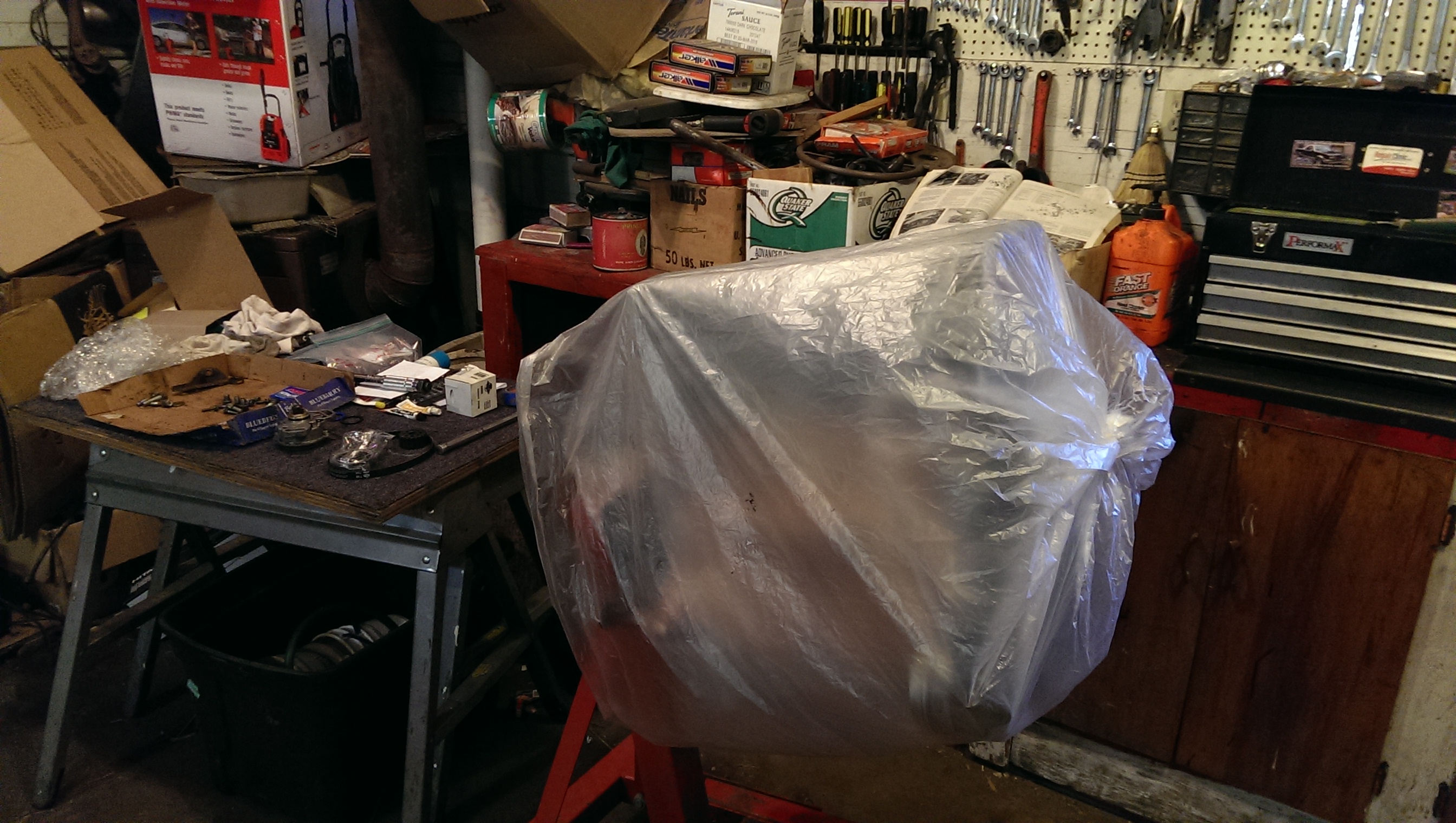No half update this time, I’ve got a nice full update for all of you! This week I managed to go all the way from the block we left off with to having the timing set. Let’s get started!
My paint arrived on Monday. After speaking to Rich Yox from Thermo-Tech and confirming that there wouldn’t be any issue painting my block with it, I decided I’d order a can of Thermo-Tec Copper High Heat Wrap Coating (I’m an Amazon affiliate now, buying through any Amazon link I post will help contribute to my crazy schemes!) as I’d seen the color on another build thread and thought it looked nice. I actually ordered it for the new exhaust header I’ve got on the way, along with one of their Copper Exhaust Wrap kits and a new harmonic balancer as my old one was showing signs of cracking. Last thing I want is my crank walking due to unbalanced harmonics. Plus, it wouldn’t sound nice.




After double checking all of my taping, doing a lot of wire wheel work (think I owe dad a new one), and covering anything I didn’t want full of paint dust, I got to spraying. I did a light coat first, then a second light coat, and a final heavier coat. I made sure to give the paint about 20 minutes between coats to dry, though it actually dries pretty fast. This is exhaust paint, so it’s going to smoke a bit as it burns in, that ought to be fun! It turned out very nice though, I’m happy with the color.




I’m thinking I might go with a silver and gold sort of theme for the engine bay, as I don’t want the bay to remain black like it is now. A nice silver would make it seem less grimy (and hopefully it will be) and should look nice against the copper accents I’ll have throughout.
The following day I reached out to ARP for some clarification on the head stud installation process, shoutout to Alan Nichols for answering all of my questions! I learned that ARP does not actually recommend doing a “re-torquing” procedure as I had seen on multiple forums, which saves some time. I made sure my block surface was clean, cleaned out the thread holes, and started screwing the studs into the block until they were hand tight. The studs got slathered with a special lubricant that ARP provides before going into the block.




After double checking that the surface was still clean (that lube gets all over the place) I started prepping the head to go on. Basically I just checked everything to make sure there wasn’t any major debris that would get in the way of a good seal with the head gasket. Satisfied, I laid my nice new Fel-Pro 1153 multi layer steel head gasket in place.
Now, some people may wonder why I’m using an expensive MLS head gasket and expensive ARP head studs. Simply put: POWA! Actually, reliability. It’s the do it once and do it right mentality, both the head gasket and studs are reusable if I ever have to take this back apart. It’s also unlikely that either of them will fail with power levels that far exceed what I’m shooting for.
Back to the build! Sam stopped by just in time to help my set the head on the studs and make sure everything got lined up correctly. Thanks Sam!





The next step is to use ARP’s provided moly lube on both sides of the washer and drop them in place. It’s fun. You have very little room to work, and the springs get in the way as you try to situate the washer. Once they get stuck, you basically have to use a hammer and screw driver to carefully tap them past the spring and into place. They are also magnetic so they like to go towards whatever they like, you’ll learn how to fish these suckers out of whatever part of the head you manage to drop them in.



Next up: the nut. This also receives a generous helping of moly lube. I found that it was easiest to use a magnet on the end of these and drop them into place. Once in place it’s pretty easy to get them hand tightened. Once hand tightened, they need to be torqued in 3 separate steps of 30, 60, and finally 90 ft/lbs. There is also a special pattern to follow, which you can see below. You start at 1, and work your way out.




Putting that much torque on them at such an odd angle is a heck of a workout. I grabbed some pictures of before and after the head was tightened down, to show how much the gasket compresses.




Neat right? The next step was getting the timing components installed and then setting the timing. This is extremely important as the 4G63T is an interference engine and I don’t want all this work to be undone in a few seconds. I did plenty of research ahead of time (VFAQ is the go-to resource for DSM modifications, there’s some great stuff there!) so that I was familiar with the process. But I didn’t want to just trust my own work, so I called up the local 4G63T engine building guru Matt and asked if there was a time he could come take a look and help my with that. We settle on a time he was free, and I got to filling my free time with cleaning more parts. All the major stuff was already done, so I found every small grubby looking piece and cleaned it up. I can now say that I literally cleaned every single bolt, nut, and washer going back on this car. I also had the horrifying revelation that I have absolutely no clue where most of these go.



Luckily, I had labeled some of them, and Mitsubishi built these engines with pretty much two grades of bolt, 7 & 4, and they almost always use a 10mm head. So it’s mostly a process of figuring out which length goes where and the service manual does have some diagrams that show bolt length. I sorted out what I did know, and then packaged everything up nicely, like I should have done when I took it apart. Note for next time, label all the things.



After a large amount of cleaning, Matt stopped by and we started in on the timing. All the components go on first, including the water pump (use a new one!) which is fairly easy if you know which bolts go where. Next up is the belt, make sure to use a new one of these as well! I got an entire Gates timing component kit from Amazon just to make sure everything was new. Nearly everything going back on this engine is new, it’s going tp be just like it came from the factory but with lots of ARP hardware (cam sprocket bolts, connecting rod bolts, head studs, crank pulley bolt, flywheel bolts).
With the belt in place, you can start lining everything up. There are timing marks on the crank pulley, the oil sprocket, and both of the cam gears. Do make sure the “dowel” the gear hooks on is at the top before you start setting the timing!





We used a ruler to make sure the cam gears were lined up with each other, and then double checked the timing marks on the bottom end. This took a bit of work and we repeated the process several times. Once you’re sure its all lined up you can pull the pin on the timing tensioner and give it a good 15 minutes to expand. Now you check everything over again, and if it’s all lined up right you can put a socket on the crank and start spinning it around. You’ll want to go 6 full rotations, and the timing should line up yet after you stop, if not, you have to start over and compress the tensioner. We got lucky (pure skill) and got it right on the first try.






Don’t worry about the giant blank space at the lower right, this is where the balance belt tnesioner and sprocket would usually go, but I’ve taken my balance shafts out. The balance shaft belt goes behind the timing belt, so you can see how that would easily cause probelms if it broke. Peace of mind and reliability are the biggest reasons to remove them, though it is a controversial topic.
So with that, the timing was set! Matt headed back home and I headed in for some cookies. I had initially tried to bribe Matt with some beer, but instead ran some cookies up to his place and helped him set 500lbs of some quick-crete style blacktop down. He needs another good 800lbs to be finished with his driveway project. Way to hot out for this sort of thing!
After that, all I really had left was to put the timing cover on and figure out which bolts went where with that. I had also tracked down and gotten new seals for the timing cover, not easy that. The old ones have a habit of drying out and cracking.


After some finagling, I got the cover in place with the seals in the right places. My cover is pretty beat up, but the price for a new one and the fact that it isn’t an essential piece had me leaning towards just keeping it as is.

So that’s all the work I’ve gotten done in the last week! I didn’t get anything else done today as I had to throw a hay wagon on top of everything else. Next up is the harmonic balancer and other accessory parts. I’ve got to order a new starter yet, and possibly an alternator, plus lots of research on the next steps. You’ll hear about it all next week!


So where did you find timing cover gaskets? I’m having a terrible time locating any at all!
That’s going to be a tough one, I didn’t have any luck finding them locally either and turned to EBay. Even then it was just luck that I found a seller that had all three of the gaskets, the seller I got mine from is j2toolsandsupply. I believe I bought the last ones they had listed, but you may get lucky and find that they have some more.
Otherwise you might have to get creative. Mine were listed as Mopar parts with the following part numbers: MD156770 for the small strip, MD006665 for the large strip, & MD121986 for the insert. Good luck!